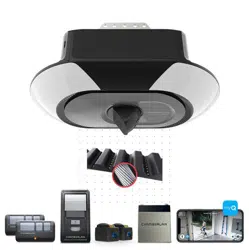Documents: Go to download!
User Manual
- Owner's manual - (English)

- Preparation
- Assembly
- Installation
- Adjustments
- Battery Backup
- myQ® App Control
- Camera
- Operation
- Maintenance
- Troubleshooting
Table of contents
Preparation
Check the Door
WARNING To prevent possible SERIOUS INJURY or DEATH:
- ALWAYS call a trained door systems technician if garage door binds, sticks, or is out of balance. An unbalanced garage door may NOT reverse when required.
- NEVER try to loosen, move or adjust garage door, door springs, cables, pulleys, brackets or their hardware, ALL of which are under EXTREME tension.
- Disable ALL locks and remove ALL ropes connected to garage door BEFORE installation and operating garage door opener to avoid entanglement.
- DO NOT install on a one-piece door if using devices or features providing unattended close. Unattended devices and features are to be used ONLY with sectional doors.
CAUTION To prevent damage to garage door and opener:
- ALWAYS disable locks BEFORE installing and operating the opener.
- ONLY operate garage door opener at 120V, 60 Hz to avoid malfunction and damage.
Before you begin:
- Disable locks and remove any ropes connected to the garage door.
- Lift the door halfway up. Release the door. If balanced, it should stay in place, supported entirely by its springs.
- Raise and lower the door to check for binding or sticking. If your door binds, sticks, or is out of balance, call a trained door systems technician.
- Check the seal on the bottom of the door. Any gap between the floor and the bottom of the door must not exceed 1/4" (6 mm). Otherwise, the safety reversal system may not work properly.
- The opener should be installed above the center of the door. If there is a torsion spring or center bearing plate in the way of the header bracket, it may be installed within 4 feet (1.2 m) to the left or right of the door center
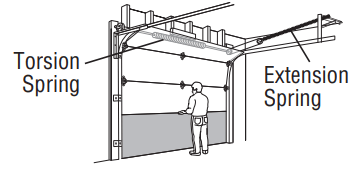
Before You Connect with Your Smartphone
Monitor and control your garage door from anywhere using the myQ® App. You will need a router with Wi-Fi® and a smartphone or other mobile device. Make sure your mobile device is connected to your Wi-Fi® network. Hold your mobile device in the place where your garage door opener will be installed and check the Wi-Fi® signal strength.

Check Signal Strength. If you see:

Wi-Fi signal is strong. You’re all set! Install your new garage door opener.

Wi-Fi signal is weak. The garage door opener will likely connect to your Wi-Fi network. If not, try one of the options below.

No Wi-Fi signal. Try one of the following:
- Move your router closer to the garage door opener to minimize interference from walls and other objects
- Buy a Wi-Fi range extender
Tools Needed

Additional Items You May Need:
Survey your garage area to see if you will need any of the following items:
- (2) 2X4 Pieces of wood : May be used to fasten the header bracket to the structural supports. Also used to position the garage door opener during installation and for testing the safety reversing sensors.
- Support bracket and fastening hardware: Must be used if you have a finished ceiling in your garage.

- Extension brackets (Model 041A5281-1) or wood blocks: Depending upon garage construction, extension brackets or wood blocks may be needed to install the safety reversing sensor.

- Fastening hardware: Alternate floor mounting of the safety reversing sensor will require hardware not provided.
- Door reinforcement: Required if you have a lightweight steel, aluminum, fiberglass or glass panel door.
- Rail extension kit: Required if your garage door is more than 7 feet (2.13 m) high.
Hardware
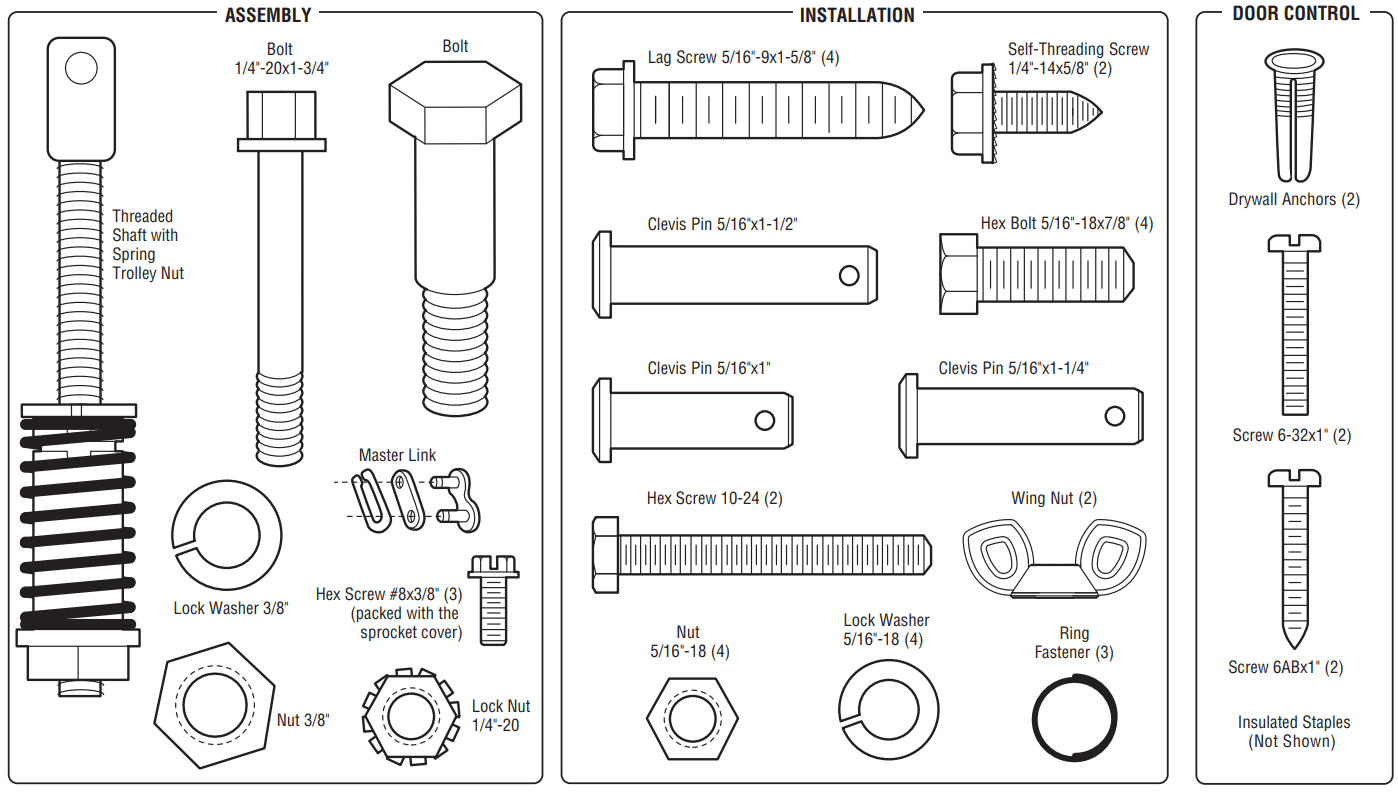
Assembly
STEP 1 Assemble the Rail and Install the Trolley
CAUTION To prevent INJURY from pinching, keep hands and fingers away from the joints while assembling the rail.
To avoid installation difficulties, do not run the garage door opener until instructed to do so.
The front rail has a cut out “window” at the door end. The rail tab MUST be on top of the rail when assembled.
- Remove the straight door arm and hanging bracket packaged inside the front rail and set aside for Installation Step 5 and 9. NOTE: To prevent INJURY while unpacking the rail carefully remove the straight door arm stored within the rail section.
- Align the rail sections on a flat surface as shown and slide the tapered ends into the larger ones. Tabs along the side will lock into place.
- Place the motor unit on packing material to protect the cover, and rest the back end of the rail on top. For convenience, put a support under the front end of the rail.
- As a temporary stop, insert a screwdriver into the hole in the second rail section from the motor unit, as shown.
- Check to be sure there are 4 plastic wear pads inside the inner trolley. If they became loose during shipping, check all packing material. Snap them back into position as shown.
- Slide the trolley assembly toward the screwdriver as shown.
- Slide the rail onto the “U” bracket, until it reaches all the stops on the top and sides of the “U” bracket.
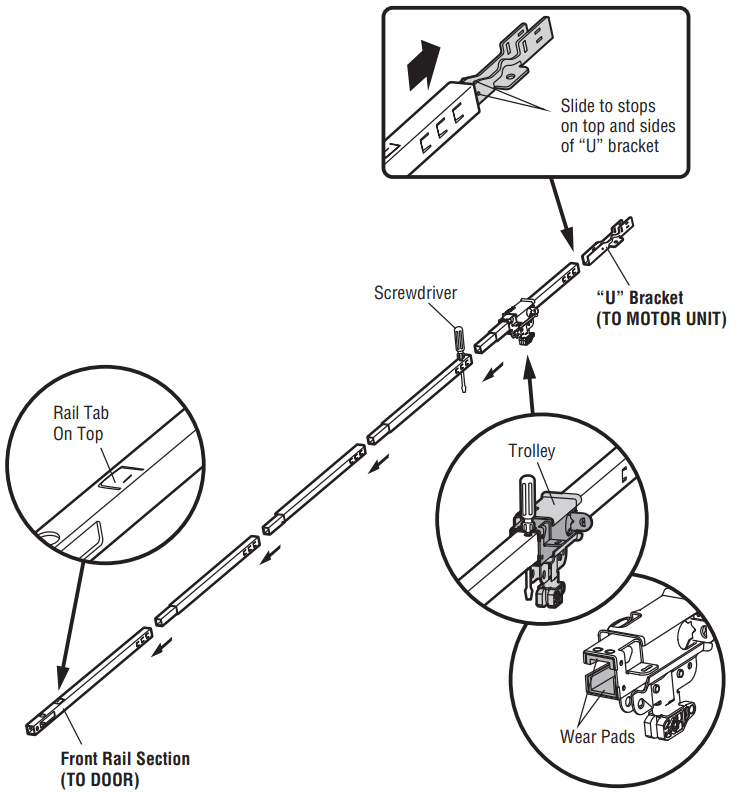
STEP 2 Fasten the Rail to the Motor Unit
CAUTION To avoid SERIOUS damage to garage door opener, use ONLY those bolts/fasteners mounted in the top of the opener.
- Insert a 1/4"-20 x 1-3/4" bolt into the cover protection bolt hole on the back end of the rail as shown. Tighten securely with a 1/4"-20 lock nut. DO NOT overtighten.
- Remove the bolts from the top of the motor unit.
- Use the carton to support the front end of the rail.
- Place the “U” bracket, flat side down onto the motor unit and align the bracket holes with the bolt holes.
- Fasten the “U” bracket with the previously removed bolts; DO NOT use any power tools. The use of power tools may permanently damage the garage door opener.

STEP 3 Install the Idler Pulley
- Lay the belt beside the rail, as shown. Grasp the end with the hooked trolley connector and pass approximately 12" (30 cm) of belt through the window. Keep the ribbed side toward the rail, and allow it to hang until Assembly Step 4.
- Remove the tape from the idler pulley. The inside center should be pre-greased. If dry, regrease to ensure proper operation.
- Place the idler pulley into the window as shown.
- Insert the idler bolt from the top through the rail and pulley. Tighten with a 3/8" lock washer and nut underneath the rail until the lock washer is compressed.
- Rotate the pulley to be sure it spins freely.
- Locate the rail tab. The rail tab is between the idler bolt and the trolley in the front rail section. Use a flathead screwdriver and lift the rail tab until the tab is vertical (90º).

STEP 4 Install the Belt
1. Pull the belt around the idler pulley and toward the trolley. The ribbed side must contact the pulley.
2. Hook the trolley connector into the retaining slot on the trolley as shown (Figure 1).
3. With the trolley against the screwdriver, dispense the remainder of the belt along the rail length toward the motor unit and around the sprocket (Figure 2). The sprocket teeth must engage the belt.
4. Check tomake sure the belt is not twisted. Connect the trolley threaded shaft with the master link (Figure 3).
a. Push pins of master link bar through holes in end of belt and trolley threaded shaft.
b. Push master link cap over pins and past pin notches.
c. Slide the closed end of the clip-on spring over one of the pins. Push the open end of the clipon spring onto the other pin.
5. Remove the spring trolley nut from the threaded shaft.
6. Insert the trolley threaded shaft through the hole in the trolley.
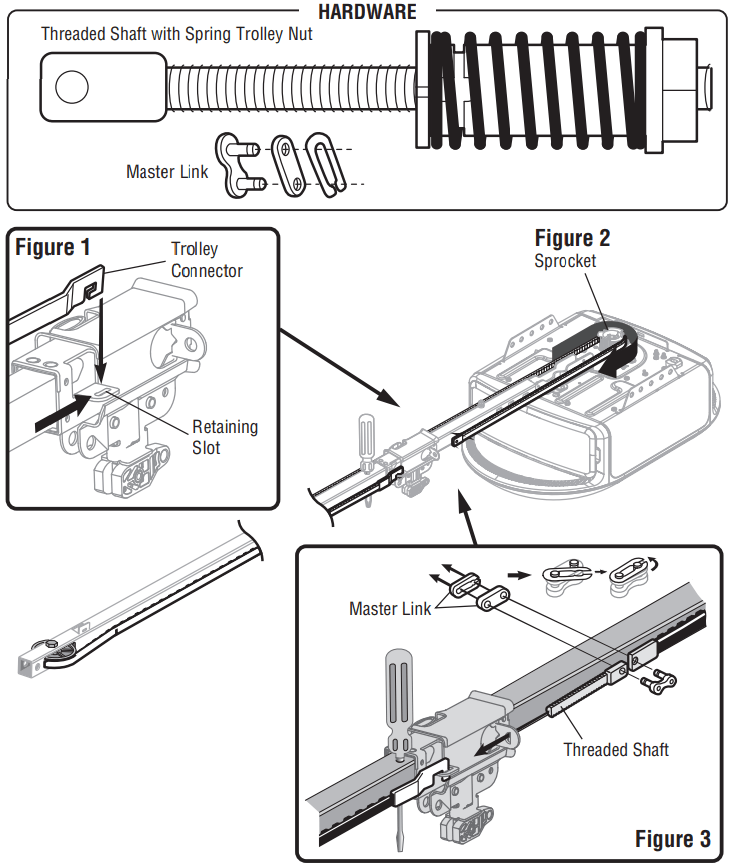
STEP 5 Tighten the Belt
- By hand, thread the spring trolley nut on the threaded shaft until it is finger tight against the trolley. Do not use any tools. Remove the screwdriver.
- Insert a flathead screwdriver tip into one of the nut ring slots and brace it firmly against the trolley.
- Tighten the spring trolley nut with an adjustable wrench or a 7/16" open end wrench about a quarter turn until the spring releases and snaps the nut ring against the trolley. This sets the spring to optimum belt tension.
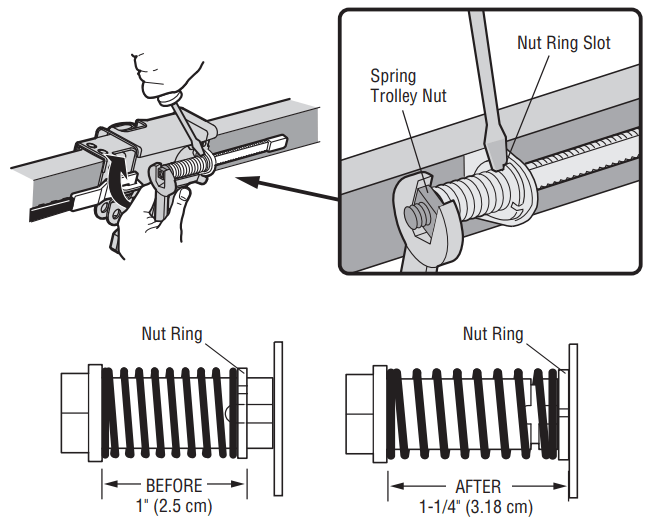
STEP 6 Install the Sprocket Cover
WARNING To avoid possible SERIOUS INJURY to finger from moving garage door opener:
- ALWAYS keep hand clear of sprocket while operating opener.
- Securely attach sprocket cover BEFORE operating.
1. Position the sprocket cover over the sprocket as shown and fasten to the mounting plate with #8x3/8" hex screws provided.
You have now finished assembling your garage door opener.
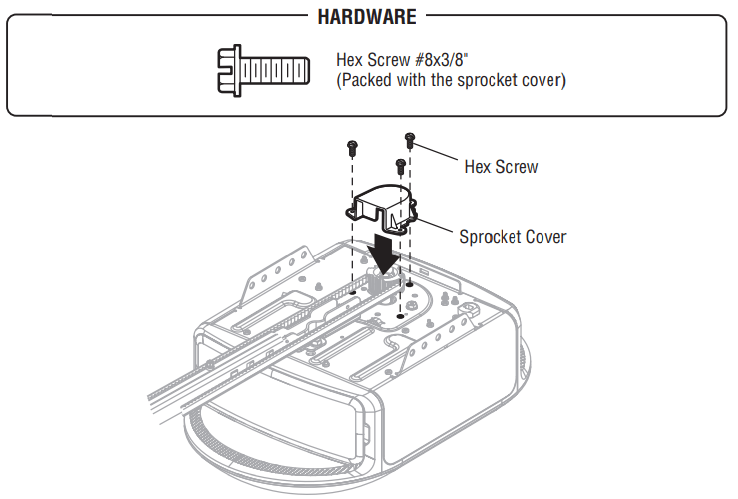
Installation
STEP 1 Determine the Header Bracket Location
WARNING To prevent possible SERIOUS INJURY or DEATH:
- Header bracket MUST be RIGIDLY fastened to structural support on header wall or ceiling, otherwise garage door might NOT reverse when required. DO NOT install header bracket over drywall.
- Concrete anchors MUST be used if mounting header bracket or 2x4 intomasonry.
- NEVER try to loosen, move or adjust garage door, springs, cables, pulleys, brackets, or their hardware, ALL of which are under EXTREME tension.
- ALWAYS call a trained door systems technician if garage door binds, sticks, or is out of balance. An unbalanced garage door might NOT reverse when required.
Installation procedures vary according to garage door types. Follow the instructions which apply to your door.
- Close the door and mark the inside vertical centerline of the garage door.
- Extend the line onto the header wall above the door. You can fasten the header bracket within 4 feet (1.22 m) of the left or right of the door center only if a torsion spring or center bearing plate is in the way; or you can attach it to the ceiling (see page 16) when clearance is minimal. (It may be mounted on the wall upside down if necessary, to gain approximately 1/2" (1 cm). If you need to install the header bracket on a 2x4 (on wall or ceiling), use lag screws (not provided) to securely fasten the 2x4 to structural supports as shown here and on page 16.
- Open your door to the highest point of travel as shown. Draw an intersecting horizontal line on the header wall 2" (5 cm) above the high point:
- 2" (5 cm) above the high point for sectional door and one-piece door with track.
- 8" (20 cm) above the high point for one-piece door without track.
This height will provide travel clearance for the top edge of the door. NOTE: If the total number of inches exceeds the height available in your garage, use the maximum height possible.
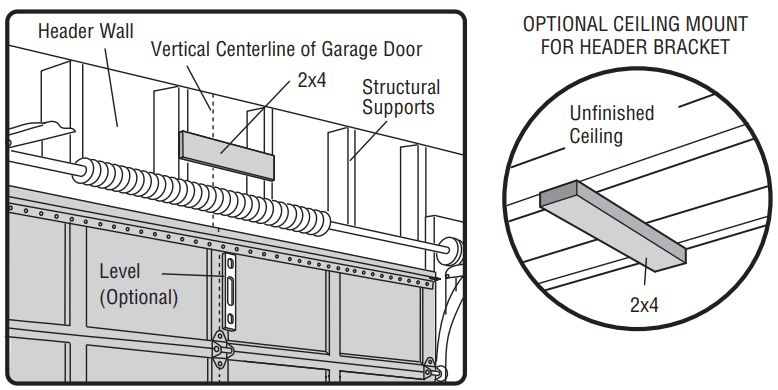
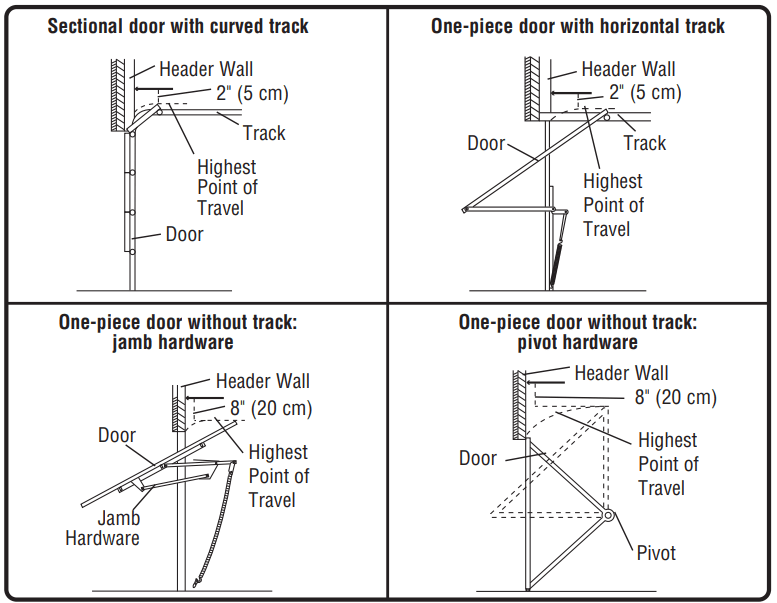
STEP 2 Install the Header Bracket
You can attach the header bracket either to the wall above the garage door, or to the ceiling. Follow the instructions which will work best for your particular requirements. Do not install the header bracket over drywall. If installing into masonry, use concrete anchors (not provided).

OPTION A - WALL INSTALLATION
- Center the bracket on the vertical centerline with the bottom edge of the bracket on the horizontal line as shown (with the arrow pointing toward the ceiling).
- Mark the vertical set of bracket holes. Drill 3/16" pilot holes and fasten the bracket securely to a structural support with the hardware provided.
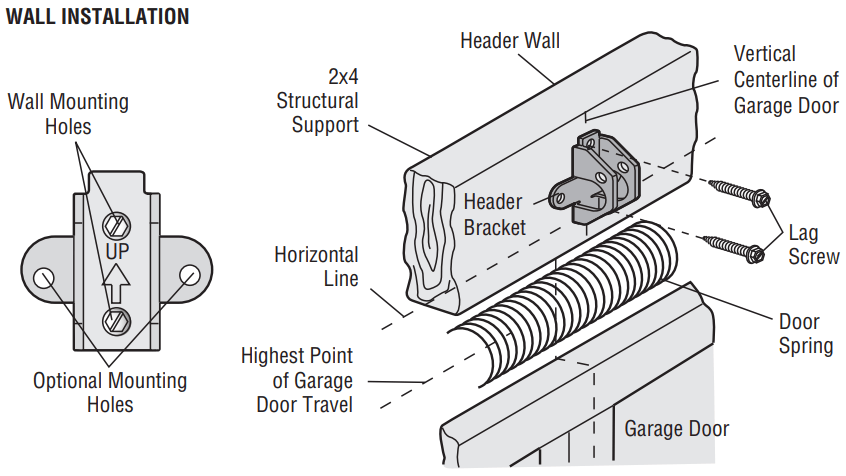
OPTION B - CEILINGINSTALLATION
- Extend the vertical centerline onto the ceiling as shown.
- Center the bracket on the vertical mark, nomore than 6" (15 cm) from the wall. Make sure the arrow is pointing away from the wall. The bracket can be mounted flush against the ceiling when clearance is minimal.
- Mark the side holes. Drill 3/16" pilot holes and fasten bracket securely to a structural support with the hardware provided.
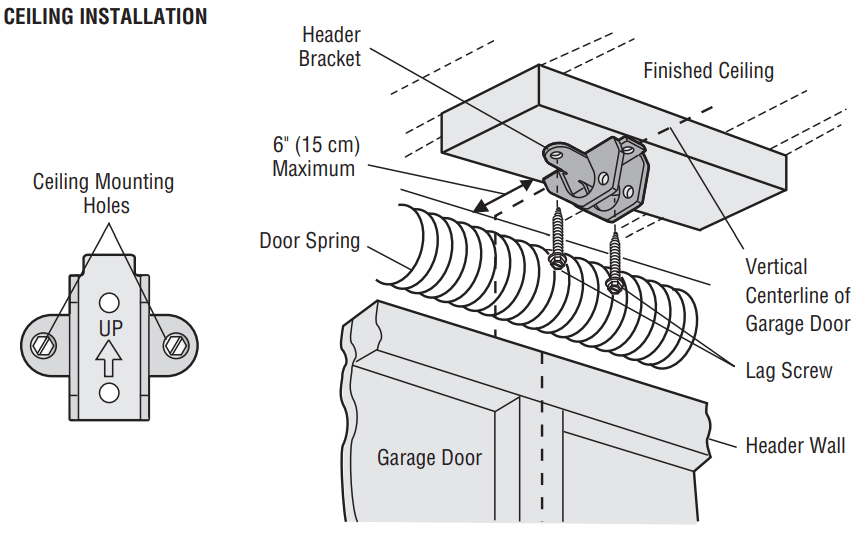
STEP 3 Attach the Rail to the Header Bracket

- Position the opener on the garage floor below the header bracket. Use packing material as a protective base. NOTE: If the door spring is in the way, you will need help. Have someone hold the opener securely on a temporary support to allow the rail to clear the spring.
- Position the rail bracket against the header bracket.
- Align the bracket holes and join with a clevis pin as shown.
- Insert a ring fastener to secure.
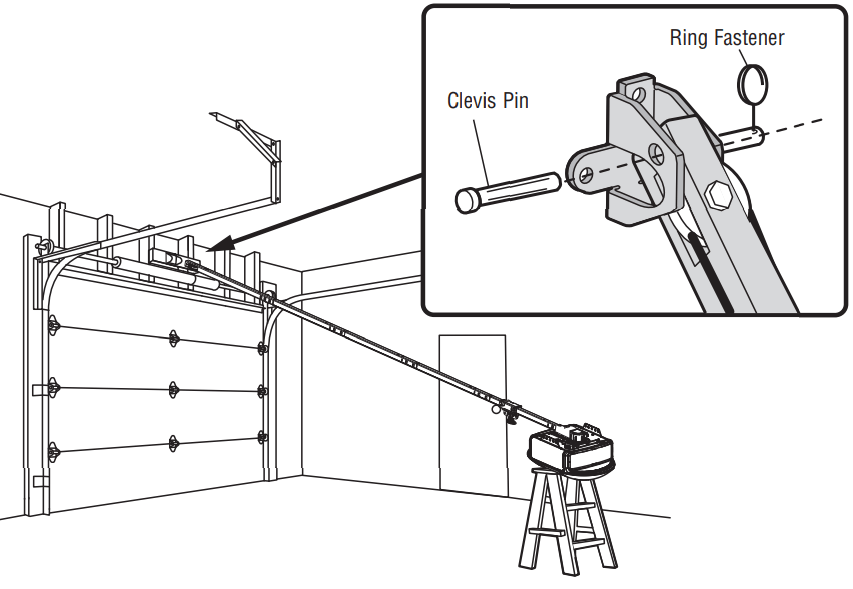
STEP 4 Position the Garage Door Opener
CAUTION: To prevent damage to garage door, rest garage door opener rail on 2x4 placed on top section of door.
- Remove the packing material and lift the garage door opener onto a ladder.
- Fully open the door and place a 2x4 (laid flat) under the rail. For one-piece doors without tracks, lay the 2x4 on it's side.
NOTE: A 2x4 is ideal for setting the distance between the rail and the door. If the ladder is not tall enough you will need help at this point. If the door hits the trolley when it is raised, pull the trolley release arm down to disconnect the inner and outer trolley. Slide the outer trolley toward the garage door opener. The trolley can remain disconnected until instructed.

STEP 5 Hang the Garage Door Opener
WARING: To avoid possible SERIOUS INJURY from a falling garage door opener, fasten it SECURELY to structural supports of the garage. Concrete anchors MUST be used if installing ANY brackets intomasonry.

Hanging the garage door opener will vary depending on your garage. Below are three example installations. Your installation may be different. For ALL installations the garage door opener MUST be connected to structural supports. The instructions illustrate one of the examples below.

1. On finished ceilings, use the lag screws to attach a support bracket (not provided) to the structural supports before installing the garage door opener.
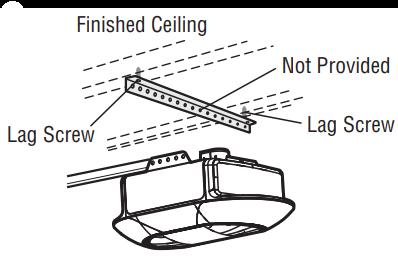
2. Make sure the garage door opener is aligned with the header bracket. Measure the distance from each side of the garage door opener to the support bracket.

3. Cut both pieces of the hanging bracket to required lengths.

4. Attach the end of each hanging bracket to the support bracket with appropriate hardware (not provided).

5. Attach the garage door opener to the hanging brackets with the hex bolts, lock washers, and nuts.
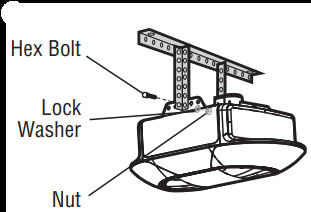
6. Remove the 2x4 and manually close the door. If the door hits the rail, raise the header bracket.
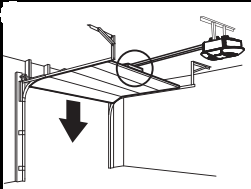
STEP 6 Attach the Emergency Release Rope and Handle
WARNING: To prevent possible SERIOUS INJURY or DEATH from a falling garage door:
- If possible, use emergency release handle to disengage trolley ONLY when garage door is CLOSED. Weak or broken springs or unbalanced door could result in an open door falling rapidly and/or unexpectedly.
- NEVER use emergency release handle unless garage doorway is clear of persons and obstructions.
- NEVER use handle to pull door open or closed. If rope knot becomes untied, you could fall.
- Insert one end of the emergency release rope through the handle. Make sure that “NOTICE” is right side up. Secure with an overhand knot at least 1" (2.5 cm) from the end of the rope to prevent slipping.
- Insert the other end of the emergency release rope through the hole in the trolley release arm. Mount the emergency release within reach, but at least 6 feet (1.83 m) above floor, avoiding contact with vehicles to prevent accidental release and secure with an overhand knot.
NOTE: If it is necessary to cut the emergency release rope, seal the cut end with a match or lighter to prevent unraveling. Ensure the emergency release rope and handle are above the top of all vehicles to avoid entanglement.

STEP 7 Install the Door Bracket
WARNING: Fiberglass, aluminum or lightweight steel garage doors WILL REQUIRE reinforcement BEFORE installation of door bracket. Contact the garage door manufacturer or installing dealer for opener reinforcement instructions or reinforcement kit. Failure to reinforce the top section as required according to the door manufacturer may void the door warranty.

A horizontal and vertical reinforcement is needed for lightweight garage doors (fiberglass, aluminum, steel, doors with glass panel, etc.) (not provided). A horizontal reinforcement brace should be long enough to be secured to two or three vertical supports. A vertical reinforcement brace should cover the height of the top panel. Contact the garage door manufacturer or installing dealer for opener reinforcement instructions or reinforcement kit.
NOTE: Many door reinforcement kits provide for direct attachment of the clevis pin and door arm. In this case you will not need the door bracket; proceed to the next step.
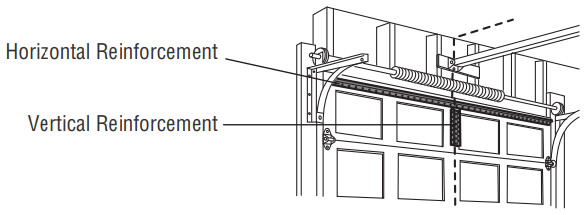
OPTION A - SECTIONAL DOORS
- Center the door bracket on the previously marked vertical centerline used for the header bracket installation. Note correct UP placement, as stamped inside bracket.
- Position the top edge of the bracket 2"-4" (5-10 cm) below the top edge of the door, OR directly below any structural support across the top of the door.
- Mark, drill holes and install as follows, depending on your door’s construction.
Metal or light weight doors using a vertical angle iron brace in the door panelsupport and the door bracket:
- Drill 3/16" fastening holes. Secure the door bracket using the two 1/4"-14x5/8" self-threading screws. (Figure 1)

- Alternately, use two 5/16"-18x2" bolts, lock washers and nuts (not provided). (Figure 2)
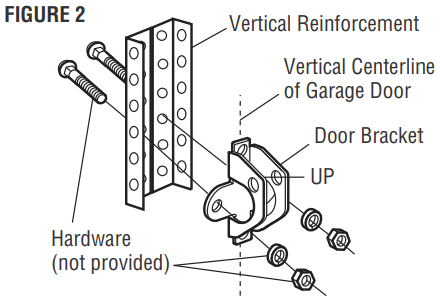
Metal, insulated or light weight factory reinforced doors:
- Drill 3/16" fastening holes. Secure the door bracket using the self-threading screws. (Figure 3)

Wood doors:
- Use top and bottom or side to side door bracket holes. Drill 5/16" holes through the door and secure bracket with 5/16"-18x2" carriage bolts, lock washers and nuts (not provided). (Figure 4)
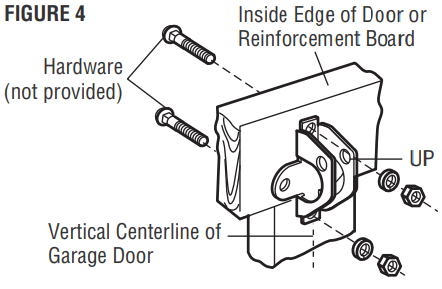
NOTE: The 1/4"-14x5/8" self-threading screws are not intended for use on wood doors.
OPTION B - ONE-PIECE DOORS
For a door with no exposed framing, or for the optional installation, use lag screws 5/16"x1-1/2" (not provided) to fasten the door bracket.

- Center the door bracket on the top of the door, in line with the header bracket as shown.
- Mark either the left and right, or the top and bottom holes.
Metal Doors:
- Drill 3/16" pilot holes and fasten the bracket with the self-threading screws provided.
Wood Doors:
- Drill 5/16" holes and use 5/16"-18x2" carriage bolts, lock washers and nuts (not provided) or 5/16"x1-1/2" lag screws (not provided) depending on your installation needs.
NOTE: The door bracket may be installed on the top edge of the door if required for your installation. (Refer to the dotted line optional placement drawing.)
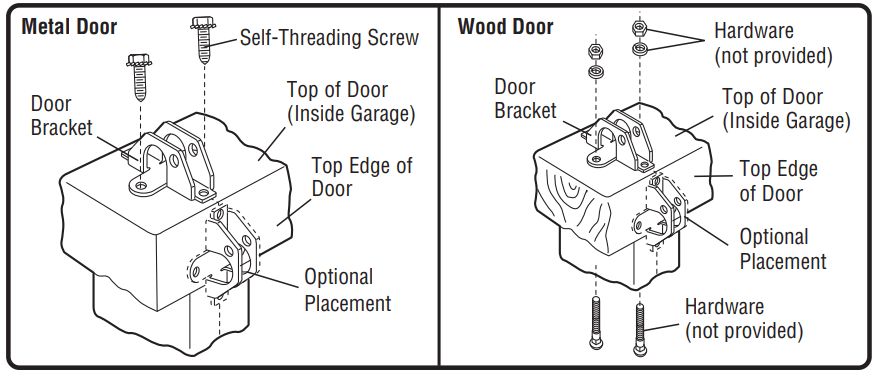
STEP 8 Connect the Door Arm to the Trolley
Installation will vary according to the garage door type. Follow the instructions which apply to your door

OPTION A - SECTIONAL DOORS
IMPORTANT: The groove on the straight door arm MUST face away from the curved door arm.
- Close the door. Disconnect the trolley by pulling the emergency release handle.
- Attach the straight door arm to the outer trolley using the clevis pin. Secure with the ring fastener.
- Attach the curved door arm to the door bracket using the clevis pin. Secure with the ring fastener.
- Bring arm sections together. Find two pairs of holes that line up and join sections. Select holes as far apart as possible to increase door arm rigidity and attach using the bolts, nuts, and lock washers.
- Pull the emergency release handle toward the garage door opener until the trolley release arm is horizontal. The trolley will re-engage automatically when the garage door opener is activated.
NOTE: If the holes in the curved door arm and the straight door arm do not align, reverse the straight door arm, select two holes (as far apart as possible) and attach using bolts, nuts, and lock washers. If the straight door arm is hanging down too far, youmay cut 6" (15 cm) from the solid end.

OPTION B - ONE-PIECE DOORS

IMPORTANT: The groove on the straight door arm MUST face away from the curved door arm.
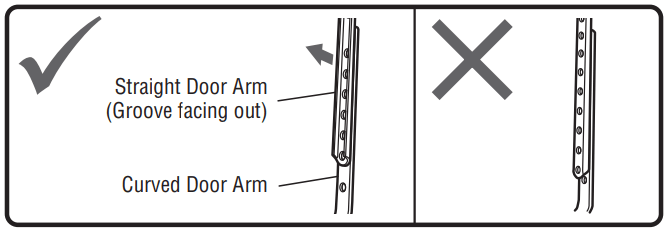
- Close the door. Disconnect the trolley by pulling the emergency release handle.
- Fasten the straight door arm and the curved door arm together to the longest possible length (with a 2 or 3 hole overlap) using the bolts, nuts, and lock washers.
- Attach the straight door arm to the door bracket using the clevis pin. Secure with the ring fastener.
- Attach the curved door arm to the trolley using the clevis pin. Secure with the ring fastener.
- Pull the emergency release handle toward the garage door opener until the trolley release arm is horizontal.
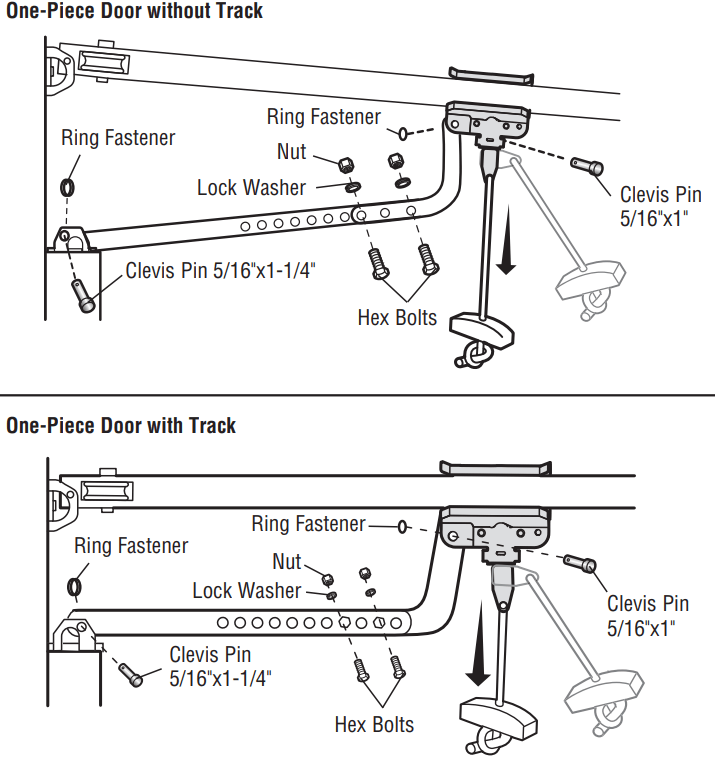
STEP 9 Install the Door Control
WARNING:
To prevent possible SERIOUS INJURY or DEATH from electrocution:
- Be sure power is NOT connected BEFORE installing door control.
- Connect door control ONLY to 12 VOLT low voltage wires.
To prevent possible SERIOUS INJURY or DEATH from a closing garage door:
- Install door control within sight of garage door, out of reach of small children at a minimum height of 5 feet (1.5 m) above floors, landings, steps or any other adjacent walking surface, and away from ALL moving parts of door.
- NEVER permit children to operate or play with door control push buttons or remote control transmitters.
- Activate door ONLY when it can be seen clearly, is properly adjusted, and there are no obstructions to door travel.
- ALWAYS keep garage door in sight until completely closed. NEVER permit anyone to cross path of closing garage door

INTRODUCTION Older Chamberlain door controls and third party products are not compatible. Install door control within sight of garage door, out of reach of small children at a minimum height of 5 feet (1.5 m) above floors, landings, steps or any other adjacent walking surface, and away from ALL moving parts of door. For gang box installations it is not necessary to drill holes or install the drywall anchors. Use the existing holes in the gang box.
NOTE: Your product may look different than the illustrations.
1. Strip 7/16" (11 mm) of insulation from one end of the wire and separate the wires.
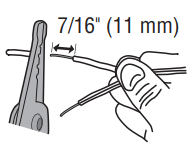
2. Connect one wire to each of the two screws on the back of the door control. The wires can be connected to either screw. If your garage is pre-wired for the door control choose any two wires to connect, note which wires are used so the correct wires are connected to the garage door opener in a later step.

3. Mark the location of the bottom mounting hole and drill a 5/32" hole.

4. Install the bottom screw, allowing 1/8" (3 mm) to protrude from the wall.
5. Position the bottom hole of the door control over the screw and slide down into place.

6. Lift the push bar up and mark the top hole.

7. Remove the door control from the wall and drill a 5/32" hole for the top screw.

8. Position the bottom hole of the door control over the screw and slide down into place. Attach the top screw.
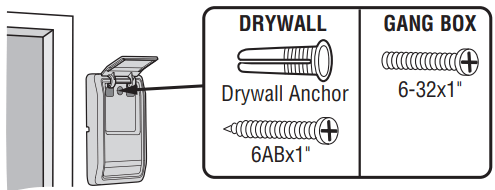
STEP 10 Wire the Door Control to the Garage Door Opener

1. Run the white and red/white wire from the door control to the garage door opener. Attach the wire to the wall and ceiling with the staple (not applicable for gang box or pre-wired installations). Do not pierce the wire with the staple as this may cause a short or an open circuit.

2. Strip 7/16" (11 mm) of insulation from the end of the wire near the garage door opener.

3. Connect the wire to the red and white terminals on the garage door opener. If your garage is prewired make sure you use the same wires that are connected to the door control. To insert or release wires from the terminal, push in the tab with screwdriver tip.

STEP 11 Attach the Warning Labels
1. Attach the entrapment warning label on the wall near the door control with tacks or staples.
2. Attach the manual release/safety reverse test label in a visible location on the inside of the garage door.
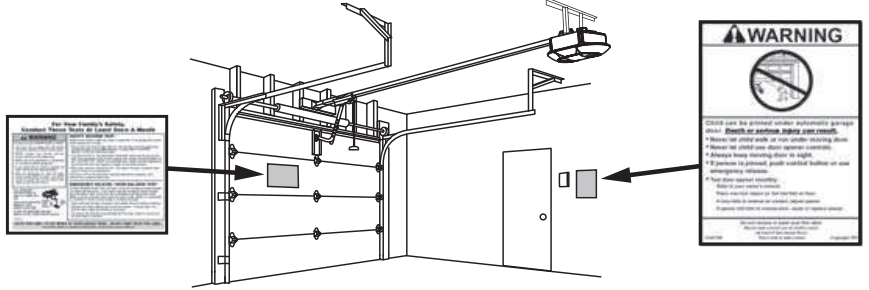
STEP 12 Install the Protector System
WARNING:
Be sure power is NOT connected to the garage door opener BEFORE installing the safety reversing sensor.
To prevent SERIOUS INJURY or DEATH from closing garage door:
- Correctly connect and align the safety reversing sensor. This required safety device MUST NOT be disabled.
- Install the safety reversing sensor so beam is NO HIGHER than 6" (15 cm) above garage floor.

IMPORTANT: The safety reversing sensors MUST be connected and aligned correctly before the garage door opener will move in the down direction.
The Protector System® includes two safety reversing sensors which use a light beam to prevent the garage door from closing. The sending sensor (amber LED) transmits the beam to the receiving sensor (green LED) when both are powered and aligned. If an obstruction breaks the light beam while the door is closing, the door will stop, and reverse to the full open position, and the garage door opener lights will flash 10 times.
When installing the safety reversing sensors, check:
- Sensors are installed INSIDE the garage.
- Sensor lenses are facing each other. IMPORTANT: Do not allow direct sunlight to the receiving sensor (green LED).
- Sensor beam is NO HIGHER than 6" (15 cm) above the floor and the light beam is unobstructed.

The safety reversing sensors are designed to clip onto the door track with the provided sensor brackets. If the door track will not support the sensor bracket a wall installation is recommended. The sensor beam should be NO HIGHER than 6" (15 cm) above the floor.
DOOR TRACK INSTALLATION
1. Slide the curved arms of the sensor bracket around the edge of the door track. Snap into place so that the sensor bracket is flush against the track.

2. Slide the hex screw through the sensor.
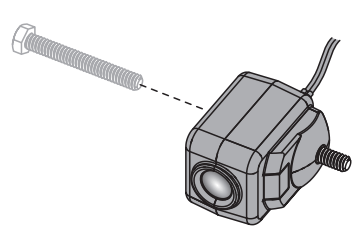
3. Attach the sensor to the bracket with the wing nut. Make sure the lens is not obstructed by the bracket.
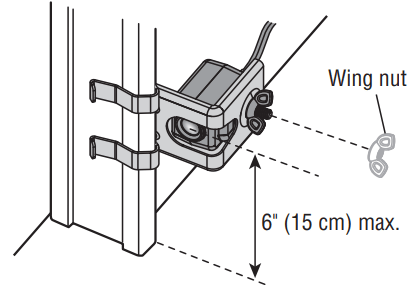
Repeat the steps with the other sensor on the opposite door track. Both lenses must face each other
WALL OPTION
Make sure the brackets on each side are clear of the door track and have the same amount of clearance so the sensors will align correctly. If additional clearance is needed, use extension brackets 041A5281-1 (not provided) or wood blocks.
1. Attach the sensor bracket against the wall with two lag screws (not provided).

2. Slide the hex screw through the sensor.
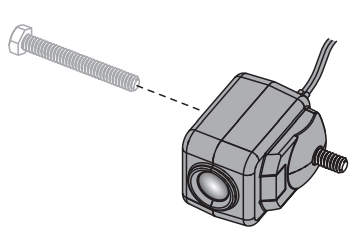
3. Attach the sensor to the bracket with the wing nut. Make sure the lens is not obstructed by the bracket.
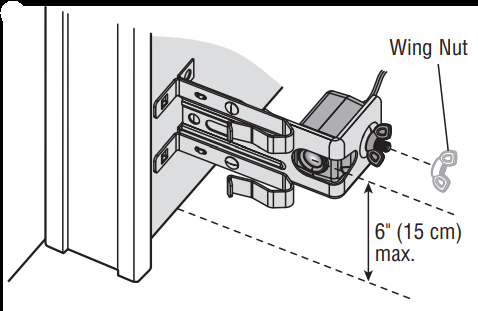
Repeat the steps with the other sensor on the opposite side of the garage door. Both lenses must face each other.
STEP 13 Wire the Safety Reversing Sensors

OPTION A - INSTALLATION WITH NO PRE-WIRING
1. Run the wire from both sensors to the garage door opener. Attach with staples, but DO NOT puncture the wire.
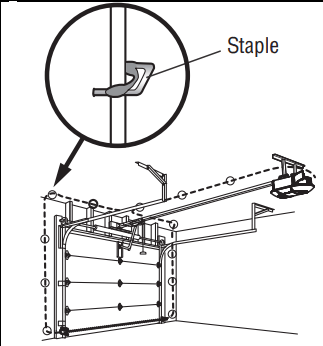
2. Separate the sensor wires and strip insulation from each end. Twist the two white wires together. Then twist the two white/black wires together.

3. Using a screwdriver, push in the terminal tabs, and insert the white wires into the white terminal. Insert the white/black wires into the grey terminal.

OPTION B - PRE-WIRED INSTALLATION
1. Cut the sensor wires, making sure there is enough wire to reach the pre-installed wires from the wall.

2. Separate the sensor wires and strip insulation from each end. Choose two of the pre-installed wires and strip insulation from each end. Choose the same color pre-installed wires for each sensor.

3. Connect the pre-installed wires to the sensor wires with wire nuts making sure the colors correspond for each sensor.

4. At the garage door opener, strip the end of the wires previously connected to the sensors. Twist the like-colored wires together.

5. Using a screwdriver, push in the terminal tabs, and insert the wire color connected to the sensor's white wire into the white terminal. Insert the other wire color connected to the sensor's white/black wire into the grey terminal.
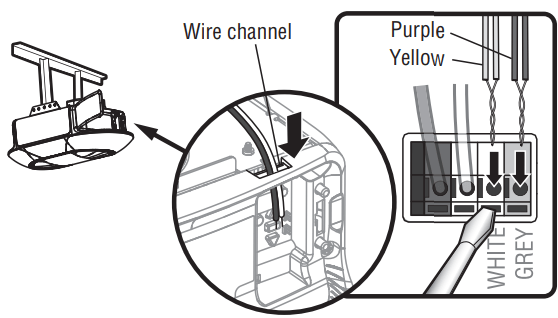
STEP 14 Connect Power
WARNING: To prevent possible SERIOUS INJURY or DEATH from electrocution or fire:
- Be sure power is NOT connected to the opener, and disconnect power to circuit BEFORE removing cover to establish permanent wiring connection.
- Garage door installation and wiring MUST be in compliance with ALL local electrical and building codes.
- NEVER use an extension cord, 2-wire adapter, or change plug in ANY way tomake it fit outlet. Be sure the opener is grounded.
To avoid installation difficulties, do not run the opener at this time.
To reduce the risk of electric shock, your garage door opener has a grounding type plug with a third grounding pin. This plug will only fit into a grounding type outlet. If the plug doesn’t fit into the outlet you have, contact a qualified electrician to install the proper outlet.

THERE ARE TWO OPTIONS FOR CONNECTING POWER:
OPTION A - TYPICAL WIRING
- Plug in the garage door opener into a grounded outlet.
- DO NOT run garage door opener at this time.
OPTION B - PERMANENT WIRING
If permanent wiring is required by your local code, refer to the following procedure. To make a permanent connection through the 7/8-inch hole in the top of the motor unit (according to local code):
- Remove the motor unit cover screws and set the cover aside.
- Remove the attached 3-prong cord.
- Connect the black (line) wire to the screw on the brass terminal; the white (neutral) wire to the screw on the silver terminal; and the ground wire to the green ground screw. The opener must be grounded.
- Reinstall the cover.

STEP 15 Align the Safety Reversing Sensors
IMPORTANT: The safety reversing sensors MUST be connected and aligned correctly before the garage door opener will move in the down direction.
When the garaged door opener has power, check the safety reversing sensors. If the sensors are aligned and wired correctly, both LEDs will glow steadily.

To align the safety reversing sensors:
- Loosen the wing nuts.
- Adjust the sensors up or down until both LEDs glow steady indicating alignment.
- Tighten the wing nut to secure the sensor.
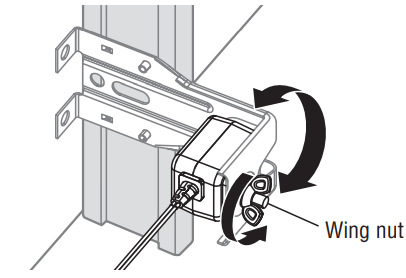
SAFETY SENSOR TROUBLESHOOTING
If either of the sensor LEDs are off, there is no power to the sensor:
1. Check that you have power to the garage door opener.
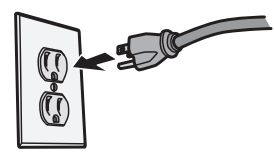
2. Check the sensor wire is not shorted or broken.
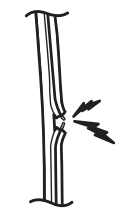
3. Check that the sensors is wired correctly; white wires to white terminal and white/black wires to grey terminal.
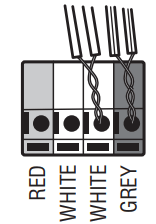
If the green receiving sensor LED is blinking, the sensors are obstructed or misaligned:
- Check for obstructions in the sensor light beam.
- Align the sensors.
- If the receiving sensor (green LED) faces direct sunlight, switch the receiving sensor with the sending sensor and repeat STEP 12 Install the Protector System®
STEP 16 Ensure the Door Control is Wired Correctly
If the door control has been installed and wired correctly, the command LED on the Motion-Detecting Control Panel will blink.
Adjustments
STEP 1 Program the Trave
WARNING: Without a properly installed safety reversal system, persons (particularly small children) could be SERIOUSLY INJURED or KILLED by a closing garage door.
- Incorrect adjustment of garage door travel limits will interfere with proper operation of safety reversal system.
- After ANY adjustments are made, the safety reversal system MUST be tested. Door MUST reverse on contact with 1-1/2" (3.8 cm) high object (or 2x4 laid flat) on floor.
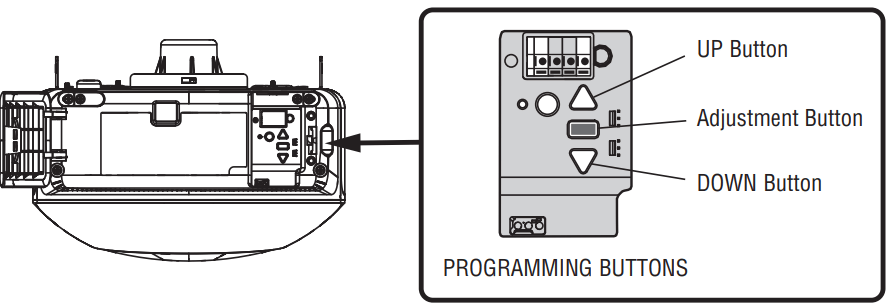
While programming, the UP and DOWN buttons can be used tomove the door as needed.
1. Press and hold the Adjustment Button until the UP Button begins to flash and/or a beep is heard.
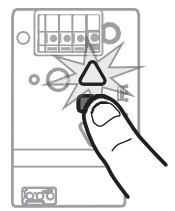
2. Press and hold the UP Button until the door is in the desired UP position.

3. Once the door is in the desired UP position press and release the Adjustment Button. The garage door opener lights will flash twice and the DOWN Button will begin to flash.

4. Press and hold the DOWN button until the door is in the desired DOWN position.

5. Once the door is in the desired DOWN position press and release the Adjustment Button. The garage door opener lights will flash twice and the UP Button will begin to flash.

6. Press and release the UP Button. When the door travels to the programmed UP position, the DOWN Button will begin to flash.

7. Press and release the DOWN Button. The door will travel to the programmed DOWN position. Programming is complete.

- If the garage door opener lights are flashing 5 times during the steps for Program the Travel, the programming has timed out. If the garage door opener lights are flashing 10 times during the steps for Program the Travel, the safety reversing sensors are misaligned or obstructed (refer to page 31). When the sensors are aligned and unobstructed, cycle the door through a complete up and down cycle using the remote control or the UP and DOWN buttons. Programming is complete. If you are unable to operate the door up and down, repeat the steps for Programming the Travel.
STEP 2 Test the Safety Reversal System
WARNING: Without a properly installed safety reversal system, persons (particularly small children) could be SERIOUSLY INJURED or KILLED by a closing garage door.
- Safety reversal system MUST be tested every month.
- After ANY adjustments are made, the safety reversal system MUST be tested. Door MUST reverse on contact with 1-1/2" (3.8 cm) high object (or 2x4 laid flat) on the floor.
1. With the door fully open, place a 1-1/2 inch (3.8 cm) board (or a 2x4 laid flat) on the floor, centered under the garage door.

2. Press the remote control or wall-mounted door control to close the door. The door should stop and reverse when it makes contact with the board. The door returns to the previous open position. Opener beeps and lights flash 5 times.

3. If the door reverses, remove the board. The test is complete.
If the door stops but does not reverse:
1. Review the installation instructions provided to insure all steps were followed;
2. Refer to Adjustment Step 1 and and set the down limit closer to the garage floor. NOTE: On a sectional door, make sure adjustments do not force the door arm beyond a straight up and down position.
3. Repeat the Safety Reversal test. If the test continues to fail, call a trained door systems technician.
STEP 3 Test the Protector System®
WARNING: Without a properly installed safety reversing sensor, persons (particularly small children) could be SERIOUSLY INJURED or KILLED by a closing garage door.
1. Open the door. Place the garage door opener carton in the path of the door.
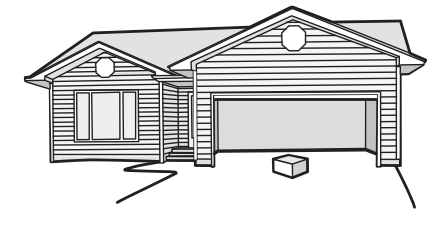
2. Press the remote control push button to close the door. The door will not move more than 1" (2.5 cm), the garage door opener lights will flash 10 times, the green LED on the receiving sensor will blink.
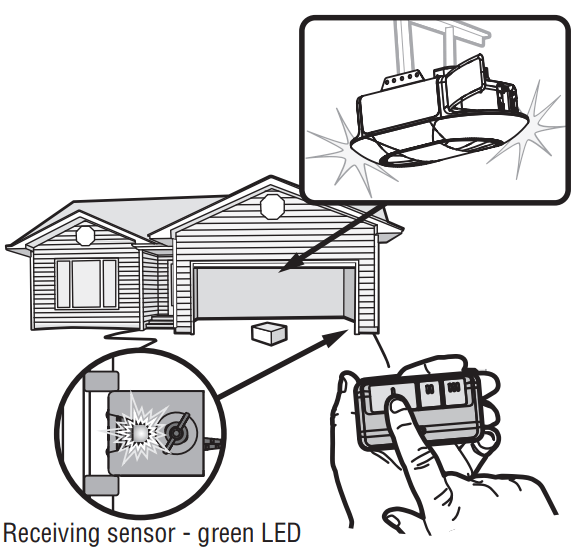
The garage door opener will not close from a remote control if the sensor light beam is misaligned or obstructed. If the garage door opener closes the door when the safety reversing sensor is obstructed (and the sensors are nomore than 6" [15 cm] above the floor), call for a trained door systems technician.
Battery Backup
STEP 1 Install the Battery
WARNING: To reduce the risk of FIRE or INJURY to persons:
- Disconnect ALL electric and battery power BEFORE performing ANY service or maintenance.
- Use ONLY Chamberlain part # G4228 for replacement battery.
- DO NOT dispose of battery in fire. Battery may explode. Check with local codes for disposal instructions.
CAUTION: ALWAYS wear protective gloves and eye protection when changing the battery or working around the battery compartment.
The battery backup allows access in and out of your garage, even when the power is out. The battery does not have to be fully charged to operate the garage door opener. When the garage door opener is operating on battery power, it may run slower and the battery status LED will glow solid orange while the motor is on. The following features are unavailable when operating on battery power:
- Garage door opener lights
- Unattended close devices and features such as myQ® App and Timer-to-Close

- Unplug the garage door opener.
- Open the control door panel on the front of the garage door opener
- Partially insert the battery into the battery compartment with the terminals facing to the right as shown.
- Connect red (+) and black (-) wires from the garage door opener to the corresponding terminals on the battery.
- Fully insert the battery and close the control door panel.
STEP 2 Test the Battery
Depending on the power level, the battery may need to charge before performing the test. The garage door opener must be unplugged to test the battery.
1. Open and close the door using the remote control or door control. While the motor is on, the battery status LED will either glow solid orange indicating opener is operating on battery power or will flash indicating low battery power. NOTE: The garage door opener may run slower if the battery is not fully charged.

2. Plug in the garage door opener. Verify the battery status LED is flashing green, indicating the battery is charging.
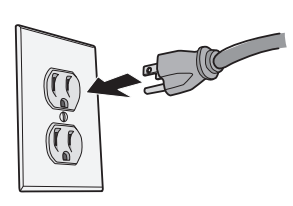
Charge the Battery
The battery charges when the garage door opener is plugged into a 120Vac electrical outlet that has power and requires 24 hours to fully charge. A fully charged battery supplies 12Vdc to the garage door opener for one to two days of normal operation during an electrical power outage. After the electrical power has been restored, the battery will recharge within 24 hours. The battery will last approximately 1 to 2 years with normal usage. Instructions for replacement are provided with the battery. To obtain maximum battery life and prevent damage, disconnect the battery when the garage door opener is unplugged for an extended period of time, such as a summer or winter home.
myQ® App Control
Connect With Your Smartphone
YOU WILL NEED:
- Wi-Fi enabled smartphone, tablet or laptop
- Broadband Internet connection
- Wi-Fi signal in the garage (2.4 GHz, 802.11b/g/n required)
- Password for your home network (router's main account, not guest network)
- myQ® serial number located on the garage door opener
DOWNLOAD THE myQ® APP TO SET UP AN ACCOUNT AND CONNECT
Open and close your door, get alerts and set schedules from anywhere. Connected smart garage door openers also receive software updates to ensure the opener has the latest operational features.
- Download the myQ® App.
- Set up an account and connect.
If you already have the myQ® App installed:
- Check that your mobile device has the latest software.
- Download the latest version of the myQ® App.
NOTES: myQ® App control WILL NOT work if the garage door opener is operating on battery power.
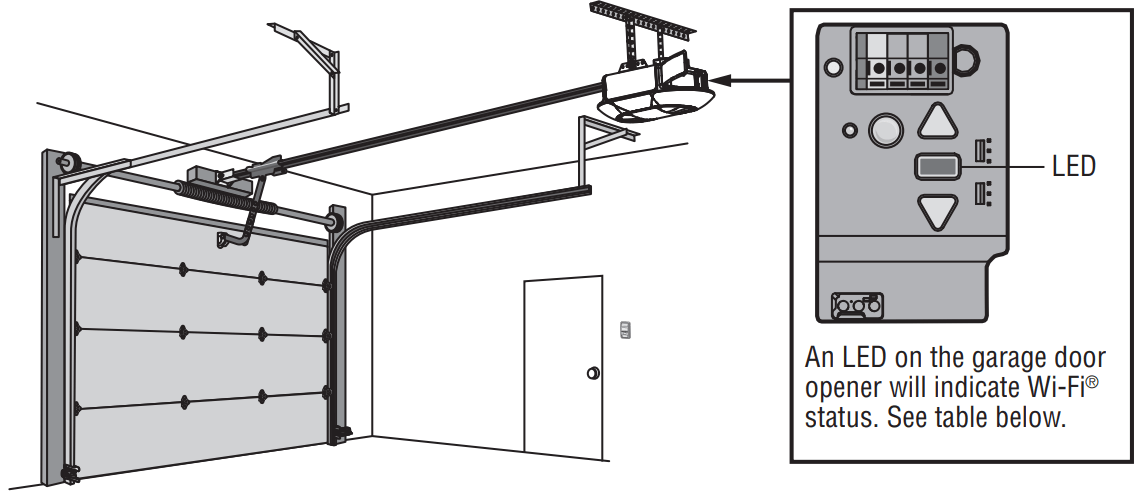
| Wi-Fi® Status | |
| LED | Definition |
| Blue | Off - Wi-Fi® is not turned on. Blinking - Garage door opener is in Wi-Fi® learn mode. Solid - Mobile device connected to the garage door opener. |
| Blue and Green | Blinking - Attempting to connect to router |
| Green | Blinking - Attempting to connect to the Internet server. Solid - Wi-Fi® has been set up and garage door opener is connected to the internet. |
Camera
Set Up the Camera
- Download the myQ® App, setup an account, and connect.
- Follow the instructions in the app to setup and use the camera.
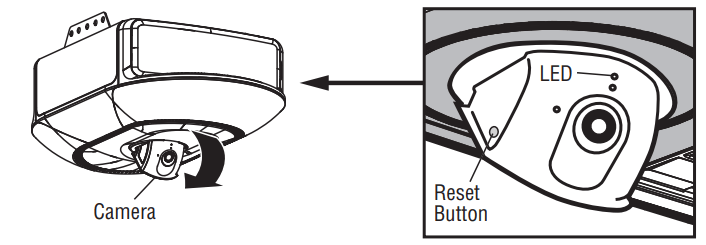
The camera powers up when it is opened and powers down when closed. An LED on the camera indicates the status. See the camera status table.
| Camera Status | |
| LED | Definition |
| Flashing Blue | Camera is attempting to connect to the mobile device |
| Solid Blue | Camera is connected to the mobile device |
| Flashing Blue and Green | Camera is attempting to connect to the router |
| Flashing Green | Camera is connected to the router and attempting to connect tomyQ® server |
| Solid Green | Camera is connected and working normally |
| Solid White | Camera is powering up. |
| Flashing Red | Camera is overheating. |
| Flashing Purple | Camera firmware is updating. |
Operation
Using your Garage Door Opener
The garage door opener can be activated through a wall-mounted door control, remote control, wireless keyless entry or myQ® App.
When the door is closed and the garage door opener is activated the door will open. If the door makes contact with an obstruction while opening, the door will stop, opener beeps and lights flash 5 times. When the door is in any position other than closed and the garage door opener is activated, the door will close. If the garage door makes contact with an obstruction while closing, the door will reverse, opener beeps and lights flash 5 times. If the obstruction interrupts the sensor beam the garage door opener lights will blink 10 times. However, you can close the door if you hold the button on the door control or keyless entry until the door is fully closed.
The safety reversing sensors do not affect the opening cycle. The safety reversing sensor must be connected and aligned correctly before the garage door opener will move in the down direction.
The garage door opener lights will turn on when the opener is initially plugged in; power is restored after interruption, or when the garage door opener is activated. The lights will turn off automatically after 4-1/2 minutes. The lights will turn on when someone enters through the open garage door and the safety reversing sensor infrared beam is obstructed, see Motion-Detecting Control Panel page 39. For energy efficiency the garage door opener will enter sleep mode when the door is fully closed. The sleep mode shuts the garage door opener down until activated. While in sleep mode the opener lights and the safety sensor LEDs will turn off. The garage door opener will not go into the sleep mode until it has completed 5 cycles upon power up.
Motion Detecting Control Panel

SYNCHRONIZE THE DOOR CONTROL: To synchronize the door control to the garage door opener, press the push bar until the garage door opener activates (it may take up to 3 presses). Test the door control by pressing the push bar; each press of the push bar will activate the garage door opener.
PUSH BAR: Press the push bar to open or close the door.
LEARN BUTTON: Use to program compatible remote controls, wireless keyless entries and myQ® devices to the garage door opener.
MOTION SENSOR: Turns the garage door opener lights on when motion is detected. Lights stay on for 4-1/2 minutes (factory setting), then turn off. Set the motion sensor switch ON or OFF to control this feature.
LOCK: Prevents remote controls from working, while still allowing activation from the door control and keyless entry. (Factory setting is OFF.)
Turn ON: Press and hold the LOCK button for 2 seconds. The command LED will flash as long as the lock feature is on.
Turn OFF: Press and hold the LOCK button for 2 seconds. The command LED will stop flashing and normal operation will resume.
LIGHT BUTTON: Turns the garage door opener lights on or off when pressed. Lights stay on for 4-1/2 minutes (factory setting). The LIGHT button will not control the lights when the door is in motion.
To change the amount of time the lights stay on:
Press and hold the LOCK button (approximately 10 seconds) until the garage door opener lights flash. The time interval is indicated by the number of times the garage door opener lights flash:
- 1 flash is 1-1/2 minutes
- 2 flashes is 2-1/2 minutes
- 3 flashes is 3-1/2 minutes
- 4 flashes is 4-1/2 minutes
To cycle through the time intervals repeat the step above. If the push bar LED is continuously blinking, the LOCK feature needs to be turned off.
To turn the light feature ON (Factory default is On):
- Close the garage door.
- Start with the garage door opener lights "ON".
- Press and hold the LIGHT button (approximately 10 seconds) until the garage door opener lights turn off, then on again.
To turn the light feature OFF:
- Close the garage door.
- Start with the garage door opener lights "OFF".
- Press and hold the LIGHT button (approximately 10 seconds) until the garage door opener lights turn off, then on again.
Remote Control and Keyless Entry
PRE-PROGRAMMED REMOTE CONTROL INCLUDED, NO NEED TO PROGRAM THE REMOTE.
To add or reprogram a remote control, follow the instructions below. Older Chamberlain remote controls are NOT compatible.
PROGRAM MOTION DETECTINGCONTROL PANEL
1. Press the LEARN button on the door control to enter programming mode. The command LED will flash once.
2. Press the LEARN button again, the command LED will flash once again.
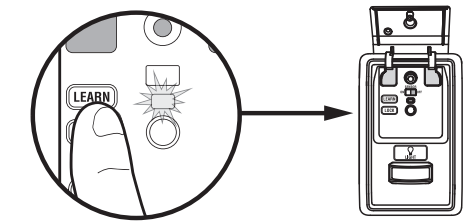
3. Remote Control: Press the button on the remote control that you wish to operate your garage door. Keyless Entry: Enter a 4-digit personal identification number (PIN) of your choice on the keyless entry keypad. Then press the ENTER button.

The garage door opener lights will flash (or two clicks will be heard) when the code has been programmed. Repeat the steps for programming additional remote controls or keyless entry devices. If programming is unsuccessful, repeat the steps using the LEARN button on the garage door opener.
PROGRAM USINGTHE GARAGE DOOR OPENER LEARN BUTTON
1. Locate the LEARN Button.
2. Press and immediately release the LEARN button. The LEARN LED will glow steady for 30 seconds. Within 30 seconds...

3. Remote Control: Press and hold the button on the remote control that you wish to use. Keyless Entry: Enter a 4-digit personal identification number (PIN) of your choice on the keyless entry keypad. Then press and hold the ENTER button. Release the button when the garage door opener lights blink or two clicks are heard.

HomeLink®
If your vehicle is equipped with HomeLink®, a Compatibility Bridge™ (not included) may be necessary for certain vehicles.
Erase the Memory
ERASE ALL REMOTE CONTROLS AND KEYLESS ENTRIES
1. Press and hold the LEARN button on garage door opener until the learn LED goes out (approximately 6 seconds). All remote control and keyless entry codes are now erased. Reprogram any accessory you wish to use.
ERASE ALL REMOTE CONTROLS, KEYLESS ENTRIES, AND myQ® DEVICES FROM GARAGE DOOR OPENER
1. Press and hold the LEARN button on garage door opener until the learn LED goes out (approximately 6 seconds).
2. Immediately press and hold the LEARN button again until the learn LED goes out. All codes are now erased. Reprogram any accessory you wish to use.
ERASE THE CONNECTION FROM GARAGE DOOR OPENER TO HOME Wi-Fi® NETWORK
1. Press and hold the black adjustment button on the garage door opener until 3 beeps are heard (Approximately 6 seconds).

ERASE THE CAMERA SETTINGS
1. Press and hold the reset button on the side of the camera for 10 seconds. The LED light will turn off, then flash red.
You will need to set up your camera again after resetting it.
To Open the Door Manually
WARNING: To prevent possible SERIOUS INJURY or DEATH from a falling garage door:
- If possible, use emergency release handle to disengage trolley ONLY when garage door is CLOSED. Weak or broken springs or unbalanced door could result in an open door falling rapidly and/or unexpectedly.
- NEVER use emergency release handle unless garage doorway is clear of persons and obstructions.
- NEVER use handle to pull door open or closed. If rope knot becomes untied, you could fall.
DISCONNECT THE TROLLEY
- The door should be fully closed if possible.
- Pull down on the emergency release handle so the trolley release arm snaps to the vertical position. The door can now be raised and lowered as often as necessary.
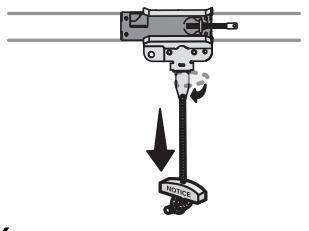
TO RE-CONNECT THE TROLLEY
1. Pull the emergency release handle toward the garage door opener so the trolley release arm snaps to the horizontal position. The trolley will reconnect on the next UP or DOWN operation, either manually or by using the door control or remote control.
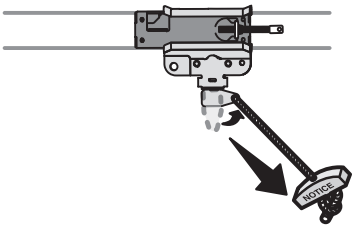
Maintenance
Maintenance Schedule
EVERY MONTH
- Manually operate door. If it is unbalanced or binding, call a trained door systems technician.
- Check to be sure door opens and closes fully. Adjust if necessary.
- Test the safety reversal system. Adjust if necessary.
EVERY YEAR
- Oil door rollers, bearings and hinges. The garage door opener does not require additional lubrication. Do not grease the door tracks.
- Test the battery backup and consider replacing the battery to ensure the garage door opener will operate during an electrical power outage.
The Remote Control Battery
WARNING:
To prevent possible SERIOUS INJURY or DEATH:
- NEVER allow small children near batteries.
- If battery is swallowed, immediately notify doctor.
To reduce risk of fire, explosion or chemical burn:
- Replace ONLY with 3V CR2032 coin batteries.
- DO NOT recharge, disassemble, heat above 212°F (100°C) or incinerate
The 3V CR2032 Lithium battery should produce power for up to 3 years. If the battery is low, the remote control’s LED will not flash when the button is pressed.
To replace battery, pry open the case first in the middle (1), then at each side (2 and 3) with the visor clip. Replace the batteries with only 3V CR2032 coin cell batteries. Insert battery positive side up. Dispose of old batteries properly.

NOTICE: This device complies with part 15 of the FCC rules and Innovation, Science and Economic Development Canada license-exempt RSSs. Operation is subject to the following two conditions: (1) this device may not cause harmful interference, and (2) this device must accept any interference received, including interference that may cause undesired operation.
Any changes or modifications not expressly approved by the party responsible for compliance could void the user’s authority to operate the equipment.
This device must be installed to ensure a minimum 20 cm (8 in.) distance is maintained between users/bystanders and device.
This device has been tested and found to comply with the limits for a Class B digital device, pursuant to part 15 of the FCC rules and Industry Canada ICES standard. These limits are designed to provide reasonable protection against harmful interference in a residential installation. This equipment generates, uses and can radiate radio frequency energy and, if not installed and used in accordance with the instructions, may cause harmful interference to radio communications. However, there is no guarantee that interference will not occur in a particular installation. If this equipment does cause harmful interference to radio or television reception, which can be determined by turning the equipment off and on, the user is encouraged to try to correct the interference by one or more of the following measures:
- Reorient or relocate the receiving antenna.
- Increase the separation between the equipment and receiver.
- Connect the equipment into an outlet on a circuit different from that to which the receiver is connected.
- Consult the dealer or an experienced radio/TV technician for help.
Troubleshooting
Diagnostic Chart
Your garage door opener is programmed with self-diagnostic capabilities. The UP and DOWN arrows on the garage door opener flash the diagnostic codes.
| DIAGNOSTIC CODE | SYMPTOM | SOLUTION | |
 |  | ||
| 1 | 1 | The garage door opener will not close and the lights flash. | Safety reversing sensors are not installed, connected, or wires may be cut. Inspect sensor wires for a disconnected or cut wire |
| 1 | 2 | The garage door opener will not close and the lights flash. | There is a short or reversed wire for the safety reversing sensors. Inspect safety sensor wire at all staple and connection points, replace wire or correct as needed. |
| 1 | 3 | The door control will not function. | The wires for the door control are shorted or the door control is faulty. Inspect door control wires at all staple and connection points, replace wire or correct as needed. |
| 1 | 4 | The garage door opener will not close and the lights flash. | Safety reversing sensors are misaligned or were momentarily obstructed. Realign both sensors until both LEDs are glowing steady. Make sure nothing is hanging or mounted on the door that would interrupt the sensor’s path while closing. |
| 1 | 5 | Door moves 6-8" (15-20 cm) stops or reverses. | Manually open and close the door. Check for binding or obstructions, such as a broken spring or door lock, correct as needed. Check wiring connections at travel module and at the logic board. Replace travel module if necessary. |
| Nomovement, only a single click. | Manually open and close the door. Check for binding or obstructions, such as a broken spring or door lock, correct as needed. Replace logic board if necessary. | ||
| Opener hums for 1-2 seconds nomovement. | Manually open and close the door. Check for binding or obstructions, such as a broken spring or door lock, correct as needed. Replace motor if necessary. | ||
| 1 | 6 | Door coasts after it has come to a complete stop. | Program travel to coasting position or have door balanced by a trained door systems technician. |
| 2 | 1-5 | Nomovement, or sound. | Replace logic board. |
| 3 | 2 | Unable to set the travel or retain position. | Check travel module for proper assembly, replace if necessary. |
| 3 | 3 | The battery status LED is constantly flashing green | Battery backup charging circuit error, replace the logic board. |
| 4 | 1-4 | Door is moving, stops or reverses. Opener beeps and lights flash. | Manually open and close the door. Check for binding or obstructions, such as a broken spring or door lock, correct as needed. If the door is binding or sticking contact a trained door systems technician. If door is not binding or sticking attempt to reprogram trave |
| 4 | 5 | Opener runs approximately 6-8" (15-20 cm), stops and reverses. | Communication error to travel module. Check travel module connections, replace travel module if necessary. |
| 4 | 6 | The garage door opener will not close and the lights flash. | Safety reversing sensors are misaligned or were momentarily obstructed. Realign both sensors to ensure both LEDs are steady and not flickering. Make sure nothing is hanging or mounted on the door that would interrupt the sensor’s path while closing. |
Additional Troubleshooting
My garage door opener stops, reverses, beeps and flashes its lights:
- Garage door opener has been activated through a device or feature such as Timer-to-Close or garage door monitor.
- Check for binding or obstructions anywhere along the track to garage floor.
My remote control will not activate the garage door:
- Verify the lock feature is not activated on the door control.
- Reprogram the remote control.
- If the remote control will still not activate the door check the diagnostic codes to ensure the garage door opener is working properly.
My door will not close and the lights blink on my opener:
The safety reversing sensor must be connected and aligned correctly before the garage door opener will move in the down direction.
- Check for binding or obstructions anywhere along the track to garage floor.
- The safety reversing sensor must be connected and aligned correctly before the garage door opener will move in the down direction.
Verify the safety reversing sensors are properly installed, aligned and free of any obstructions.
If the receiving sensor (green LED) faces direct sunlight, switch the receiving sensor with the sending sensor so the receiving sensor is not in direct sunlight.
My garage door opener light(s) will not turn off when the door is open:
The garage door opener is equipped with a feature that turns the light on when the safety reversing sensors have been obstructed or when the motion sensor on the door control detects movement in the garage. These features can be disabled using the door control, see your door control in the Operation section.
Wi-Fi® troubleshooting
The garage door opener will NOT enter Wi-Fi® learn mode:
- After the initial installation of the garage door opener, the garage door opener must complete a full cycle (open and closed) before the Wi-Fi® learn mode can be activated.
- If there has been a recent power outage, the garage door opener must complete a full cycle before the Wi-Fi® learn mode can be activated.
My vehicle's Homelink® is not programming to my garage door opener:
Compatibility Bridge (not included) may be necessary for certain vehicles.
My neighbor’s remote control opens my garage door:
Erase the memory from your garage door opener and reprogram the remote control(s).
Garage door opener LED lights not working:
Unplug the garage door opener. Remove the cover and make sure the LED wiring is connected.
Safety sensor LED lights are not lit:
The opener may be in sleep mode. The sensor LEDs will turn on when the opener is activated. If the sensor LEDs do not glow steadily when the opener is activated
Green battery status LED: Allsystems are normal.
- A solid green LED light indicates the battery is fully charged.
- A flashing green LED indicates the battery is being charged.
Orange battery status LED: The garage door opener has lost power and is in battery backup mode. While in batt
- Solid orange LED while the motor is on, indicates the garage door opener is operating on battery power.
- A flashing orange LED while the motor is on, indicates the battery is low.
Red battery status LED: The garage door opener's 12V battery needs to be replaced.
- A solid red LED indicates the 12V battery will no longer hold a charge.

See other models: 7708CB B4643T KLIK3U-BK 940EV KLIK2U
